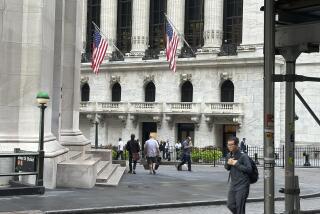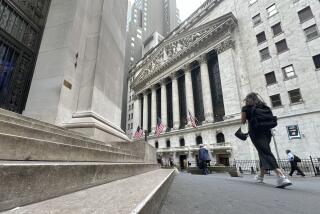Dow Takes Worst Drubbing Since January, Falling 48.24
- Share via
The budding stock market rally of 1988 got a swift kick backward Thursday as a blitz of computerized program selling and profit taking late in the session pushed the Dow Jones industrial index to its worst decline in nearly two months.
The widely watched index fell 48.24 points to close at 2,026.03, its largest loss since a 57.20-point drop on Jan. 20. The decline was broad and sudden, affecting blue chips as well as over-the-counter stocks, with virtually all of the Dow’s decline coming in the last hour of trading.
The 2.33% drop deflated at least some of the optimism of many analysts and investors, who in recent days had begun proclaiming that a new bull market had risen from the ashes of the Oct. 19 crash.
Market watchers were left divided by Thursday’s fall, with some calling it a temporary stall in a long-term rally that will set new post-crash highs above 2,100 on the Dow. Others, however, labeled the decline as the opening salvo of a sharp correction that could push the Dow well into the 1,900 range before buying enthusiasm resumes.
The selloff, analysts said, was largely triggered by profit taking from traders who simply felt that the market, at least for now, would be unable to sustain its recent rally, in which the Dow rose nearly 200 points in four weeks to set a post-crash high of 2,081.07 on Tuesday, breaking out of its recent trading range between 1,750 and 2,050.
That rally was fueled in part by surging takeover activity and by institutional money managers buying stocks so that their reports for the end of the first quarter could show a higher participation in equities.
But traders had been hoping for a rise above the 2,100 level on the Dow, which didn’t materialize, indicating that the trauma of the October debacle is still hindering many investors from jumping headlong into stocks.
“Nobody will get caught up in a mania anymore,” said Hugh A. Johnson, chief investment officer at First Albany Corp. “When the market gets caught up at overpriced levels, it brings all the sellers out.”
The decline, some experts said, also was the stock market’s way of catching up with the bond market, which had weakened in recent days amid economic reports showing a stronger-than-expected economy and a rise in oil prices on Thursday. A strong economy and higher inflation could add pressure for higher interest rates, which hurt bonds and stocks.
Stocks also felt some pressure from rumors of impending indictments in the Wall Street insider trading scandal--rumors subsequently denied by the U.S. attorney’s office in New York.
The decline worsened in the last hour or so of trading, when computerized sell programs went into action. Large institutional investors, seeing that stock index futures had become relatively cheap compared to the underlying stocks in those indexes, bought futures and sold stocks, driving down equity prices in a flurry.
However, the selling pressure fell short of pushing the Dow 50 points below Wednesday’s close, a level that would have activated the New York Stock Exchange’s rule restricting access to its automated order execution system used to carry out program trades. That rule is triggered when the Dow rises or falls at least 50 points from the previous day’s close.
Since the Big Board adopted the rule in early February, the Dow has approached the triggering level three times but never passed it. In two earlier cases, it had nearly reached the upper boundary of a 50-point gain.
Expects More Declines
Some analysts suggested that the 50-point limit acted as a floor on Thursday’s selloff and that more program trading selling pressure could resume today.
Thursday’s relatively moderate volume of 197.26 million shares on the NYSE--down from 210.90 million on Wednesday and lower than the 200-million-plus share days of other major market swings--indicates that more declines are ahead in the next few days, said Stan Weinstein, editor of the Professional Tape Reader, a newsletter in Hollywood, Fla.
“You’re in for a rough next couple of weeks,” he said, contending that lower volume on a day like Thursday indicated that few buyers were around to counteract the selling pressure.
Other bearish experts said the market is mimicking the trading pattern of 1930, when the Dow recovered about 50% of its loss from the 1929 crash, only to fizzle out and eventually set new lows.
But other analysts pooh-poohed the bearish talk and said the rally should resume soon. The recent surge in corporate takeovers, high cash reserves among institutional investors and a stable dollar--which will attract foreign investors--indicate a continued bullish trend, said Donna Hostetler, director of research at the Los Angeles brokerage of Crowell, Weedon & Co.
“The volatility will remain, but the trend is up,” she said. “I have a hard time making a negative case.”
But negatives abounded Thursday. Secondary issues of smaller companies, which have led the market rally since December, shared in the decline. The American Stock Exchange market value index fell 3.58 to close at 296.00, ending a string of 11 straight advances. The NASDAQ composite index of over-the-counter stocks fell 3.52 to finish at 376.76, only its second drop in the past month.
Broad Declines
Standard & Poor’s index of 400 industrials fell 6.21 to close at 306.25, while S&P;’s 500-stock composite index fell 5.22 to end at 263.84.
Declining issues outnumbered advances by nearly 3 to 1 on the NYSE, with 419 issues up, 1,202 down and 382 unchanged.
Takeover stocks were among the hardest hit, as some investors wondered whether the recent flurry of deals and rumored deals had been overdone. For example, AFG Industries fell 5 to close at 31 5/8 after Forstmann Little & Co., a major leveraged buyout firm, dropped a bid for the glass-making firm. Some other takeover stocks, such as Federated Department Stores and Koppers, also fell. Federated closed at 64 3/4, off 7/8, while Koppers ended the day at 51, off 1.
More to Read
Inside the business of entertainment
The Wide Shot brings you news, analysis and insights on everything from streaming wars to production — and what it all means for the future.
You may occasionally receive promotional content from the Los Angeles Times.










